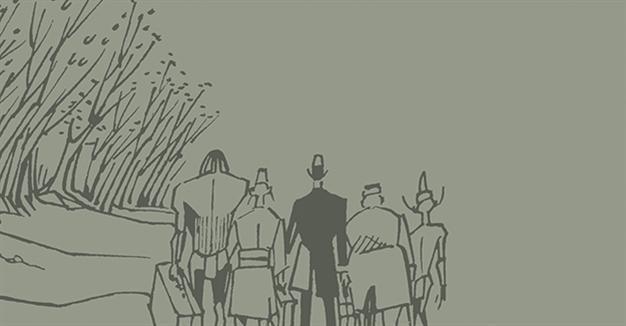Abdülcanbaz, the Formidable Turk, meets readers in English
Emrah Güler

“Abdülcanbaz is a turning point in the domain of comic strips. Turhan Selçuk’s famous comic series, with its skillful drawings, revolutionary content and impactful style, is an outstanding example to world comics,” said Genco Erkal, the great Turkish theater actor of five decades. “Can Abdülcanbaz be the very basic material for the theater which we’ve been longing for?”
Abdülcanbaz is an Istanbul gentleman and the Formidable Turk. He uses his remarkable powers to help the virtuous, the just and the downtrodden. He is honest and brave. He is handsome, witty and smart, with muscles of steel. He is famous for his “Ottoman Slap,” with which he brings down tyrants and scoundrels.
Abdülcanbaz, the ultimate Turkish comic book hero, has managed to stay relevant for over half a century. The comic albums were created by the late Turkish artist Selçuk in 1957 as a comic book for daily Milliyet, with the famous writer and humorist Aziz Nesin as his writing partner. Now, many of Abdülcanbaz’s adventures are available in English.
Abdülcanbaz took life at the turn of the century in the last days of the Ottoman Empire. His adventures met the readers through the pages of dailies Milliyet, Yeni İstanbul, Akşam and Cumhuriyet, as well as independent publications. Abdülcanbaz was adapted to the screen in 1966 before being portrayed in stage productions in 1972 and 1994. The Turkish Post Office even issued a stamp to honor this timeless Turkish hero.
In the beginning, Abdülcanbaz’s character was far from the virtuous, charismatic, honest and courageous character that he has been come to known for. He was a tourist guide with shady morals. But that didn’t stay too long when Abdülcanbaz received a makeover from Selçuk, who began writing and drawing the strip on his own. He soon blossomed as a true hero with the manners of a true gentleman.
Famous Ottoman slapAbdülcanbaz became the idealized and caricaturized version of a Turkish man, with his sleek moustache reminiscent of the Ottoman janissaries. Wearing a fez at times, and wearing it very well, Abdülcanbaz was a fashion icon long before men were expected to be chic.
Early in the life of the strip, Selçuk let a penniless Abdülcanbaz sleep in a dog’s house. In this atypical uncomfortable night, Abdülcanbaz saw a dream where he was living in the Ottoman Empire, hence the beginning of his adventures among the Ottomans. From then on, Abdülcanbaz and his friends broke free of the boundaries of time and place.
They went to the distant future to a world war between the two supposed superpowers, America and Japan, to outer space, to the Turkish Independence War, to gangsters in the 1930s in America, to ancient Mesopotamia, to seven layers beneath the Earth, and to the mystical land of Fonjistan.
Abdülcanbaz and his weirdly eclectic friends and enemies also met historical names like the 17th-century Ottoman traveler Evliya Çelebi, the 16th-century Ottoman Admiral Turgut Reis, Al Capone, as well as the Knights of St. John. They also shared adventures with other fictional heroes like the gentleman thief, Arsène Lupin.
Abdülcanbaz is a man of physical prowess, and even of superpowers at times, though he mostly prefers to use his wits and the famous Ottoman slap across the face with the speech balloon of “Şraaak!” covering the panel to dramatic effect.
Brains before brute force
He is also the epitome of a ladies’ man, not unlike another gentleman hero, James Bond, with voluptuous, sensuous women gracing the strips in nearly every adventure. The names of Abdülcanbaz’s women are matched only by their larger-than-life characters, like Earthshattering Saliha, Raziyah the Peddler, Ramona and Elefteria.
“Although Abdülcanbaz is presented as having supernatural powers, he features a conscious, discerning personality and puts his brains before brute force,” Selçuk said of his hero. “He is drawn with, not round and soft, but neat and pronounced lines. His adventures are beyond time and place.”
Selçuk cited Abdülcanbaz’s huge success, since its first publication in the dailies in 1957, partly “to the rise in popularity of the traditional literary folk arts,” referring in particular to Karagöz and Hacivat, the traditional Turkish shadow play popularized during the Ottoman era. “In the storylines, similar to Karagöz and Hacivat, we find contrasting interactions, conflicts and advocacies between the straightforward public and the ones against the welfare of the public.”
Before his death, Selçuk transferred all rights of his work on Abdülcanbaz to Group Biz Art Collection to ensure all aspects of his legend was protected and promoted. The group has been doing an impressive job revamping Abdülcanbaz to new media, and introducing him to new generations.
Selected adventures, like “Memoirs of a Dog,” “Voyage to the Land of Craters” and “Petroleum Wars,” are now available in English in a digital format. Check www.abdulcanbaz.biz for the adventures of the Formidable Turk in English.
 “Abdülcanbaz is a turning point in the domain of comic strips. Turhan Selçuk’s famous comic series, with its skillful drawings, revolutionary content and impactful style, is an outstanding example to world comics,” said Genco Erkal, the great Turkish theater actor of five decades. “Can Abdülcanbaz be the very basic material for the theater which we’ve been longing for?”
“Abdülcanbaz is a turning point in the domain of comic strips. Turhan Selçuk’s famous comic series, with its skillful drawings, revolutionary content and impactful style, is an outstanding example to world comics,” said Genco Erkal, the great Turkish theater actor of five decades. “Can Abdülcanbaz be the very basic material for the theater which we’ve been longing for?”